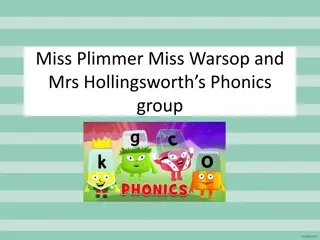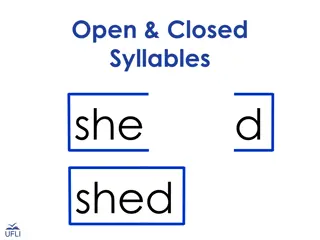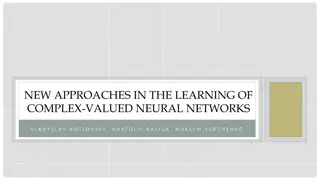Understanding English Syllables: Structure and Description
Explore the concept of syllables in English phonetics through an in-depth analysis of syllabic structure, sonority, constituents, rhyme, nucleus, coda, and phonological perspectives. Delve into the definition of a syllable, its importance in speech production, and the phonetic descriptions of syllab
2 views • 38 slides
Understanding the Importance and Nature of Syllables
Syllables play a crucial role in speech rhythm, yet their definition and identification can vary among individuals. The nature of syllables, encompassing vowels, consonants, onsets, and codas, can be analyzed phonetically and phonologically. This article explores syllable structures and phonotactics
2 views • 18 slides
Understanding English Syllables: Phonetics and Linguistics Insights
Explore the concept of syllables in English phonetics and linguistics, learning about syllable formation, examples of mono and disyllabic words, and the role of vowels and consonants in syllable structure. Delve into the essence of syllables as individual sound units within words. Discover more thro
11 views • 8 slides
Sentence Structures: Simple, Compound, Complex, and Compound-Complex
Learn about the different types of sentence structures - simple, compound, complex, and compound-complex - through examples and definitions. Understand the components of clauses and sentences, including independent and dependent clauses, to enhance your understanding of English grammar.
2 views • 11 slides
Understanding Stress in English Pronunciation
Stress in English pronunciation refers to the emphasis placed on specific syllables within words. This helps distinguish degrees of emphasis or contrast in syllables, aiding in clear communication and word recognition. Learning about stress patterns is crucial for effective English communication. Th
1 views • 27 slides
Understanding Types of Sentences - Simple, Compound, and Complex
Explore the characteristics of simple, compound, and complex sentences with examples. Learn how to differentiate between these sentence types based on their structures and conjunctions used. Enhance your understanding of sentence construction and improve your writing skills.
1 views • 18 slides
Phonics Group Activities for Syllables Learning
Engage in fun activities with Miss Plimmer, Miss Warsop, and Mrs. Hollingsworth's phonics group to explore syllables. Play games, identify syllables in words, and complete daily activities for an interactive learning experience.
0 views • 20 slides
Overview of Lipids: Classification and Biological Importance
Lipids are organic substances that play a crucial role in biological systems. They include simple lipids, complex lipids like phospholipids and glycolipids, and derived lipids. Simple lipids are esters of fatty acids with various alcohols, while complex lipids are sub-classified based on the type of
2 views • 38 slides
Understanding Dactylic Hexameter in Latin Poetry
Latin poetry employs a rhythmic structure known as meter to enhance meaning and poetic effect. Particularly, dactylic hexameter is a prevalent meter in ancient epic poetry, consisting of six feet predominantly made up of dactyls—a long syllable followed by two short syllables. Scanning dactylic he
0 views • 9 slides
Mastering Open and Closed Syllables: Fun Learning Activities
Explore the world of open and closed syllables through engaging activities with words like "she," "shed," "be," "bed," "he," "hex," and more. Practice transitioning from open to closed syllables and enhance your phonics skills with interactive exercises.
0 views • 25 slides
Understanding Biosynthetic Pathways in Living Organisms
Biosynthesis, also known as anabolism, involves the formation of complex organic compounds from simple subunits catalyzed by enzymes within living organisms. This process is vital for the development of life and the production of essential compounds like carbohydrates, proteins, vitamins, antibiotic
1 views • 21 slides
Comprehensive Guide to Complex Numbers - Learning Objectives, Key Concepts, and Previous Knowledge Testing
This comprehensive guide provides detailed information on complex numbers, including learning objectives such as identifying complex numbers, applying algebra, understanding properties like conjugates and moduli, finding square roots, and representing in polar form. Key concepts covered include inte
3 views • 27 slides
Understanding Types of Sentences in English Grammar
Simple, compound, and complex sentences are fundamental components of English grammar. Simple sentences express a single complete thought, compound sentences combine two independent clauses with a conjunction, and complex sentences consist of an independent clause and one or more dependent clauses.
2 views • 12 slides
Understanding Syllable Types in English Language
Syllables in English are categorized into open and closed syllables based on their endings. Open syllables have an onset and nucleus without a coda, while closed syllables include a coda. Additionally, syllables can be simple (with a vowel or single consonant) or complex (with consonant clusters). T
0 views • 6 slides
Mastering Sentence Types: Simple, Compound, and Complex Structures
Diving into the world of sentence construction, we explore the beauty of Simple, Compound, and Complex sentences. Learn how to differentiate between Clauses and Phrases, craft Independent and Subordinate Clauses, and understand why these elements are crucial for engaging writing. Discover the art of
1 views • 23 slides
Introduction to Rugby: A Simple but Complex Game Explained
Explore the world of rugby with insights into the game's history, rules, team composition, and the art of passing. Learn about the dynamics of rugby matches and how the sport has evolved into one of the most popular games globally. Experience the thrill of playing rugby through engaging visuals and
0 views • 25 slides
Mastering Reported Speech: Simple Present to Simple Past
Learn how to convert statements from the simple present tense to the simple past tense in reported speech with clear examples. Practice exercises are provided for better understanding, covering various sentence structures including negative sentences and present continuous to past continuous transfo
0 views • 45 slides
Understanding Tonic Solfa and "Do-Re-Mi" in Music
Tonic solfa is a method of teaching music using solfege syllables like Do, Re, Mi, Fa, So, La, Ti, Do. The iconic song "Doe, a Deer" from "The Sound of Music" famously uses these syllables to teach pitch and melody. Explore the world of solfa notation and how it helps in music education and practice
0 views • 7 slides
Learning Algorithms in Simple and Complex Games
This paper by Viliam Lisý from the Artificial Intelligence Center at Czech Technical University in Prague discusses algorithms for learning in both simple and complex games. It explores the different strategies and techniques used in artificial intelligence to improve players' performance and decis
0 views • 130 slides
Understanding Latin Syllables and Vowel Length Rules
Learn about the division of Latin words into syllables based on vowels, the rules for accent positions, distinguishing long and short vowels through special marks, and recognizing syllables that are always long or short. Explore how Latin vowels are categorized by nature and marked in dictionaries t
0 views • 24 slides
Understanding Simple Past Tense in English: Rules and Examples
The simple past tense is a fundamental form in Modern English used to describe past events. It involves regular verbs adding "-ed" and irregular verbs having different forms. The construction of the simple past helps distinguish it from other past tense forms like past perfect and past progressive.
0 views • 33 slides
Understanding Types of Sentences - Simple, Compound, Complex
Explore the different types of sentences - simple, compound, and complex. Learn about coordinating and subordinating conjunctions that play key roles in forming these sentences. Understand how to identify and construct each sentence type. Dive into the world of sentence structures and enhance your g
0 views • 18 slides
Exploring the Art of Writing Sonnets and Understanding Iambic Pentameter
Uncover the beauty of sonnets and the significance of iambic pentameter in poetic works. Dive into the rhythmic structure, syllables, and poetic meter, discovering the allure and impact of writing in iambic pentameter alongside exploring the phonological intricacies of syllables.
0 views • 25 slides
Mapping Project Overview and Attributes
This content provides detailed information about a mapping project involving the transition from S.S-53 to S-124, including complex and simple attributes, spatial references, and metadata. It covers aspects such as domain models, NAVWARN preamble, complex vs. simple attributes, and more. The content
0 views • 23 slides
English Verb Tense Review: Simple Present and Simple Past
Simple Present Tense is used for habitual actions, unchanging truths, and general statements of fact. It is indicated by words like always, usually, and sometimes. Simple Past Tense is used for completed actions and past habits indicated by words such as yesterday and last night. The forms and indic
0 views • 46 slides
Understanding the Past Simple Tense in English Grammar
The past simple tense refers to actions that occurred at a specific time in the past and are now completed. This tense follows a specific rule where the subject is combined with a verb (regular or irregular) and a complement. Adverbs like "yesterday," "ago," and "last" are commonly used with past si
0 views • 9 slides
Understanding Past Simple Tense in English Grammar
The past simple tense is used to describe completed actions or events that happened at a specific time in the past. Regular verbs form the past simple by adding "-ed", while irregular verbs have unique past tense forms. The structure for negative and question forms involves the auxiliary verb "did".
0 views • 6 slides
Mastering Present Perfect Simple: Rules, Examples, and Practice
Explore the Present Perfect Simple tense with rules, examples, and practice exercises. Learn how to form positive, negative, and question sentences using time expressions. Dive into short forms, negatives, questions, and more to enhance your understanding. Complete letters using Past Simple of Prese
0 views • 8 slides
Streamlining Field Service & Maintenance with SIMPLE Platform
Easily manage field service and maintenance tasks with the SIMPLE platform integrated with workflow and management applications. Learn how SIMPLE simplifies preventive maintenance, visual inspection reports, component inspections, and more. Overcome challenges in field service processes and track pe
0 views • 19 slides
Transforming Complex Sentences to Simple Sentences - Lesson Overview
In this lesson, students will learn how to transform complex sentences to simple sentences in English grammar. The lesson covers the structure of complex sentences using conjunctions like "Though" and "Although" and guides students on converting them into simple sentences with expressions like "In s
0 views • 12 slides
Understanding Complex Numbers in Mathematics
Learn about complex numbers, including real and imaginary parts, operations with complex numbers, the imaginary unit, equality of complex numbers, and finding square roots of negative numbers. Explore how to define and use the imaginary unit, add, subtract, and multiply complex numbers, find complex
0 views • 17 slides
COMPLEX ANALYSIS
Complex analysis explores the properties and behavior of complex functions and numbers. Topics covered include functions of complex variables, limits, continuity, and differentiability. Understanding concepts like the Cauchy-Riemann equation is crucial in studying complex valued functions. This fiel
0 views • 9 slides
Exploring Complex Numbers in Mathematics
Delve into the world of complex numbers through solving quadratic equations with real coefficients that have complex solutions, extending polynomial identities to include factoring with complex numbers, rewriting expressions, and understanding imaginary numbers. Discover the process of finding compl
0 views • 16 slides
Understanding Iambic Pentameter: Shakespeare's Versification
Iambic Pentameter is a verse rhythm popular in Shakespearean works, featuring 10 syllables per line with alternating stressed and unstressed beats. It distinguishes high-class characters from lower-class ones and allows for creative variations by changing stress patterns and adding syllables. An Iam
0 views • 47 slides
Online Class on Simple-Complex Topic at Bangladesh Noubahini School & College, Kaptai
Welcome to an Online Class at Bangladesh Noubahini School & College, Kaptai, where Mohammed Nurul Absar, Lecturer in English, is presenting a lesson on Simple-Complex topics for students of classes IX-XI. The lesson aims to enhance students' abilities to solve simple-complex problems and understand
0 views • 10 slides
Mastering Complex Reflections in Motivational Interviewing
Bill Miller, co-creator of Motivational Interviewing, emphasizes the importance of reflections in MI, highlighting Simple Reflections and Complex Reflections. Complex Reflections, such as CARVED HAM and VERDACHAM, offer deeper insights by going beyond what is said to provide new perspectives and enh
0 views • 5 slides
Learn Passive Voice in Present Simple and Past Simple Tenses for 9th Grade
Explore examples and practice sentences to understand how to form passive voice in present simple and past simple tenses. Learn how to transform active voice sentences into passive voice and enhance your English grammar skills effectively.
0 views • 10 slides
Understanding Simple Past Tense in Grammar
In this file, we delve into the concept of simple past tense in grammar. Through examples and explanations, you will learn how to use the simple past tense to talk about completed actions in the past. The structure, usage, and importance of simple past tense are covered extensively to enhance your u
0 views • 30 slides
New Approaches in Learning Complex-Valued Neural Networks
This study explores innovative methods in training complex-valued neural networks, including a model of complex-valued neurons, network architecture, error analysis, Adam optimizer, gradient calculation, and activation function selection. Simulation results compare real-valued and complex-valued net
0 views • 12 slides
Sentence Transformation Lessons - Simple to Complex
Learn how to transform sentences from simple to complex with practical examples and explanations. Enhance your English language skills by understanding the various structures and forms used in sentence transformation. Explore different scenarios and master the art of creating complex sentences from
0 views • 15 slides







































